




Last modified: August 26, 2021
Small World Networks - SWN:






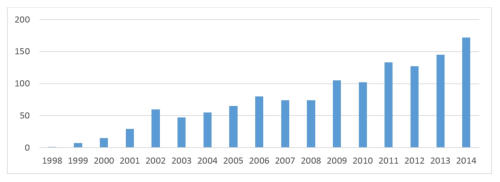
Below is a chart showing the number of publications indexed each year at www.pubmed.gov concerning small world
networks (SWN).
I will continue to use icons (see below) to explain my 2010 theory which 1) predicted the phenomenon of TAG Sync, 2)
provided a new model of sickness behavior (SBeh), and 3) offered a new theoretical interpretation of
electroencephalography (nTIE). My theory applies the constructal law of physics (CLaw) (Bejan 1997, 2012) to the
brain and its environments and suggests that adaptation involves global broad band synchronization (GBBS) over
small world networks (SWN) operating at or near self-organized criticality (SOC). Failure of adaptive (constructal)
growth I call “apoptosis of the self” (cf. sickness behavior) and show that it is detectable in the EEG by a failure of
cross-frequency coupling, a reduction in complexity, and intrusion of sub-vigilant states as described by Ulrich (2013).
Much of this work comes from my attempts to develop technology assisted self-regulation (TASR) such as
neurofeedback to function as an adaptogen as in the networks of traditional Asian medical systems (TAMS).
Here are the icons I use to point towards these fundamental concepts, mostly discussed separately elsewhere. Here
we discuss small world networks.
CLaw GBBS SWN SOC SBeh nTIE TAMS
A network is a configuration of more or less independent units (called nodes, hubs or modules), plus the
communication channels which connect them (called links, edges, pathways, tracts or wiring). The nodes can be
people, devices, molecules, communities, concepts, or discrete regions of the cortex. In the case of the nodes and
hubs of the cortex the pathways (”edges”) include both long and short distance white matter tracts which are subject to
network attack. I will show how neurofeedback can precondition the connectome to be resilient to network attack. I will
show how this appears in the real-time qEEG of the spectral display and envelopes instrument, etc., as well as in the
raw EEG.
Imagine you have 16 nodes and 32 wires to connect them. These nodes could represent discrete cortical hubs and the
wires (”edges”) white matter tracts that connect the hubs. For convenience the nodes are each represented by a black
dot, and the dots (nodes) are arranged in a circle. We will investigate three different wiring strategies which we are
called regular, small world, and random.

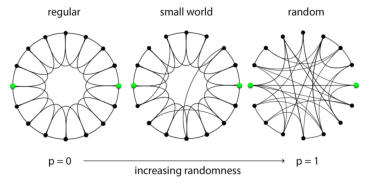
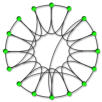
N
Neurofeedback strengthens the connectome against network attack.
The small world network of the human connectome is embedded in small world networks of social,
cognitive, technological and environmental interactions. In turn we host small world networks of
bones, microbes, genes, proteins and so forth. Global broad band synchronization over small world
networks operating near self-organized criticality is essential for growth and survival. Failure of this
process leads to canonical sickness behavior and “apoptosis of the self”.
Each of the three network types has 16 nodes and 32 “edges” with which to connect the nodes.
Regular network: (also called rigid or lattice network): In our example, every node has 4 edge connections to 4
other nearby nodes. You could call each node plus its neighbors a cluster “(C)”. Note that in order to get from one
green node to the other in this rigid network requires traveling a path length (”L”) of at least 4 edges (count the
shortest path between the green dots.)
Random network: Some nodes may have less or more clustering (”C”) than the rigid/regular network. Note that in
order to get from one green node to the other requires traveling a path length of only 1 edge, not a minimum of 4 as
for the rigid regular network. Note that some nodes have fewer connections (reduced clustering). This reduces their
modularity and makes them more prone to dysregulation and network attack.
Small world network: In between the rigid and the random networks is another type of network called the “small
world network”. Notice that it took 3 jumps to get from one of the green nodes to the other (not 4 jumps as in the rigid
network or 1 jump as in the random network). In the small world network the nodes are less clustered than in the
rigid network but more clustered than in the random network.
The illustration below shows that somewhere along the continuum between rigid and random there is a range (seen
in green in the middle) in which 1) the clustering (modularity) is high enough yet 2) the average path length between
nodes is small enough.
In the region (green) where modularity (clustering) is high enough and average path length is short enough, one finds
the emergent small world characteristics of organisms/organizations that persist and resonate over space and time. It is
only within this narrow band that systems adapt/persist/evolve (APE). As we will see, reductions in clustering (C) and/or
increases in path length (L) often lead to sickness behavior. More importantly, adaptogens (including neurofeedback)
function to optimize “C” and “L”.
Single channel neurofeedback can increase the clustering coefficient “C” by synchronizing the cortex under the single
exploratory electrode. Dual and multi channel neurofeedback can reduce average path length “L” by adding extra
edges between nodes.
Improvement in small world network efficiency may be the most important factor in relapse (sickness) prevention.


Neurofeedback (NFB) strengthens the
connectome against network attack. Single
channel NFB can increase the clustering
coefficient (”C”) of a single node. Dual channel
NFB can add extra shortcuts to reduce
average path length (”L”) and improve small-
world network efficiency.

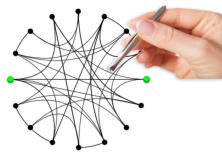
Small World Networks and Sickness Behavior:
My model of sickness behavior (SBeh - discussed elsewhere) is that it involves
maladaptive behavior and pre-programmed apoptosis of the self resulting from
inadequate global broad band synchronization (GBBS) over small world networks
(SWN) operating at or near self-organized criticality (SOC). It is triggered by such
events as prenatal and childhood adversity, trauma, toxins, genetics and familial
factors, chronic social defeat, chronic predator stress, inadequate neuroprotection
and neuroplasticity, and so forth. The effects include the loss of white matter
connections (as suggested in the accompanying illustration) and reduction of small
world network efficiency. Neurofeedback functions like an adaptogen to increase
processing efficiency and reduce sickness behavior. Two channel synchrony training
adds long distance shortcuts to the SWNs.
Vincent K, et al (2013) - Altered network communication following a neuroprotective
drug treatment. PLoS One. 2013; 8(1):e54478. [Free Full Text]
TAG Sync - a sudden increased synchronization of theta, alpha and gamma EEG - appears to be the EEG signature of
insight, the gap/bardo between two thoughts, and updating of the inner world map. In 2013 Borjigin, et al showed it to
be the EEG signature of the near death experience. I discovered this signature in 2009-2010 and developed a protocol
to produce this phenomenon over the DMN/FPN Kernal. I call this the “General Adaptation Protocol - GAP”.
In 2005 Fair et al described the maturing architecture of the brain’s default network. I have adapted Fair’s Fig 3 to
show the difference between the DMN of a 7-9 year old child and that of an adult. This is a very important point
because later studies by Daniels et al showed that many individuals with overwhelming childhood adversity remain
stunted, perhaps for life, with the connectome of a 7-9 year old.
Default Mode Network / Frontal-Parietal Network Kernal - DMN/FPN Kernal
Note the tweezers in the image. This symbolizes the plucking and dissipation of essential connections (”edges”)
between nodes. Some 7-9 year olds never develop the connectome of the adult. As discussed above there are many
reasons for developmental failure. Those with a 7-9 year old connectome, regardless of biological age, are
fundamentally missing the connections shown on the right above in “Children vs. Adults”. You may recognize the
DMN/FPN kernal described above. This can be trained by observing TAG sync (cross-frequency coupling) over the
DMN/FPN kernal using 2 exploratory electrodes at a time (2 channel NFB). I call this the general adaptation protocol -
GAP.
Let’s take a look in detail at the expected but not always attained development over time of four of the network
connections shown above. The charts below were adapted from Fair et al (2013) and show alterations in the correlation
coefficient (r) between two nodes as it changes between ages 7 and 30.
The failure of long distance connections to develop beyond those of a 10 year old (see graphs below) reduces the
efficiency of the small world networks. This may represent a tipping point at which simple adolescent neuroses turn into
adult neuropsychiatric conditions such as depression, anxiety, schizophrenia, epilepsy, dementia, etc. - all of which
include canonical sickness behavior. (Servaas et al 2015).

So single channel neurofeedback (NFB) may increase the Clustering Coefficient “C” in the region below the electrode,
say F3 in the illustration below. Two channel neurofeedback, by introducing synchrony between two sites, say F3 and
P3 (the left FPN network), can add a long distance shortcut to the connectome and reduce the average path length
“L”. In this way NFB acts as an adaptogen by increasing small world network efficiency (increased “C” and decreased
“L”), and by increasing processing of complexity.
How does neurofeedback add random edges (connections) to increase small world network
efficiency?
“… simultaneous activation of two brain regions communicating through phase synchronization will probably also
induce synaptic plasticity between these regions. This is particularly likely when phase synchronization-mediated
communication occurs repeatedly or for an extended period…Moreover, if synaptic connections between two
regions have been strengthened, phase synchronization may be more easily induced, and the two regions will be
more likely to communicate with each other.” Fell et al 2011.
![Borjigin J, et al (2013) - Surge of neurophysiological coherence and connectivity in the dying brain. Proc Nat Acad Sci, Aug 14, 2013. [Free Full Text] Daniels JK, et al (2011) - Default mode alterations in posttraumatic stress disorder related to early-life trauma - a developmental perspective. J Psychiatry Neurosci 2011;36(1) p56. [Free Full Text] Fair DA, et al (2008) - Fair DA, et al (2008) - The maturing architecture of the brain's default network. Proc Nat Acad Sci. Vol 105, no. 10, Mar 11, 2008, 4028-4032. [Free Full Text] Fell J, et al (2011) - The role of phase synchronization in memory processes. Nature Reviews Neuroscience, Vol 12, Feb 2011, pp 105-118. [Abstract] Servaas MN, et al (2015) - Connectomics and Neuroticism - An Altered Functional Network Organization. Neuropsychopharmacology 40, 296-304. [Abstract] General references for the page.](index_htm_files/5370.png)


Craniopathy, Small World Networks and Neurofeedback.
“... the human skull is a small world network, with two well delimited connectivity modules: one facial organized around the ethmoid bone, and one cranial organized around the sphenoid bone.” [1] This is a wonderful example of the nested embedding of small world networks. The SWNs of the brain are embedded in the more rigid SWNs of the cranium, embedded in the SWNs of body, environmental, social, technological and informational SWNs. It is not surprising that disturbances in the small world networks of the brain’s cranial environment can lead to executive dysfunction [3]. Neurofeedback may be facilitated by recognizing the role of the craniosacral reciprocal tension network in executive dysfunction as well as susceptibility to chronic naso-sinus fungal biofilm [4] and direct brain reactivity [5]. Network support and neuroplasticity (needed for effective NFB) can be impaired due to common TMJ and bite problems - “occlusal disharmony” [6, 7]. It is interesting to reconsider Janet Travell who on page 112 of Volume 1 of “Myofasical Pain and Dysfunction” cites her experience with orthotics to correct postural instability due to Morton’s foot (a second metatarsal or toe longer than the first). Within moments of standing on corrective orthotics some clients could open their jaws 20-30% wider. It is also interesting to know that recently “Morton’s long second toe” has been found to be a genetic marker for pyridoxal 5’ phosphate single nucleotide polymorphisms which have a great effect of neuroprotection and neuroplasticity, glucose tolerance, metabolic syndrome, etc. [8] [1] Esteve-Altava B, et al (2013) - Grist for Riedl's mill: a network model perspective on the integration and modularity of the human skull. J Exp Zool B Mol Dev Evol. 2013 Dec; 320(8):489-500. [Abstract] [2] Brook AH, et al (2014) - General and craniofacial development are complex adaptive processes influenced by diversity. Aust Dent J. 2014 Jun; 59 Suppl 1:13-22. [Abstract] [3] Beckett JS, et al (2014) - Altered brain connectivity in sagittal craniosynostosis. J Neurosurg Pediatr. 2014 Jun; 13(6):690-8. [Abstract] [4] Brewer JH, et al (2014) - Chronic illness associated with mold and mycotoxins - is naso-sinus fungal biofilm the culprit. Toxins 6, 66-80. [Free Full Text] [5] Kare MR, et al (1969) - Direct Pathway to the Brain. Science, Vol. 163, No 3870 (Feb 28, 1969), pp. 952-953. [Abstract] [6] Mori D, et al (2013) - Occlusal disharmony leads to learning deficits associated with decreased cellular proliferation in the hippocampal dentate gyrus of SAMP8 mice. Neuroscience Letters 534 ( 2013) 228-232. [Abstract] [7] Kubo KY, et al (2007) - Occlusal disharmony induces spatial memory impairment and hippocampal neuron degeneration via stress in SAMP8 mice. Neuroscience Letters 414 (2007) 188-191. [Abstract] [8] Nichols TW, et al (2014) - Morton's foot and pyridoxal 5'-phosphate deficiency: genetically linked traits. Med Hypotheses. 2014 Dec; 83(6):644-8. [Abstract]
Illustration adapted from Watts DJ, Strogatz SH (1998) - Collective
dynamics of 'small world' networks. Nature. 1998 Jun 4;
393(6684):440-2.
Illustration adapted from Watts DJ, Strogatz SH (1998) - Collective
dynamics of 'small world' networks. Nature. 1998 Jun 4;
393(6684):440-2.





Last mod: Aug 26, 2021
Small World Networks - SWN:
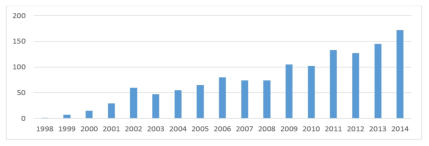
Neurofeedback strengthens the connectome against network
attack.”
The small world network of the human connectome is embedded in small
world networks of social, cognitive, technological
and environmental interactions. In turn we host
small world networks of bones, microbes, genes,
proteins and so forth. Global broad band
synchronization over small world networks
operating near self-organized criticality is essential
for growth and survival. Failure of this process leads
to canonical sickness behavior and “apoptosis of
the self”.
Below is a chart showing the number of publications indexed each year at
www.pubmed.gov concerning small world networks (SWN).
I will continue to use icons (see below) to explain my theory which in
2010 1) predicted the phenomenon of TAG Sync, 2) provided a new
model of sickness behavior (SBeh), and 3) offered a new theoretical
interpretation of electroencephalography (nTIE). My theory applies the
constructal law of physics (CLaw) (Bejan 1997, 2012) to the brain and its
environments and suggests that adaptation involves global broad band
synchronization (GBBS) over small world networks (SWN) operating at
or near self-organized criticality (SOC). Failure of adaptive (constructal)
growth I call “apoptosis of the self” (cf. sickness behavior) and show that
it is detectable in the EEG by a failure of cross-frequency coupling, a
reduction in complexity, and intrusion of sub-vigilant states as described
by Ulrich (2013). Much of this work comes from my attempts to develop
technology assisted self-regulation (TASR) such as neurofeedback to
function as an adaptogen as in the networks of traditional Asian medical
systems (TAMS).
Here are the icons I use to point towards these fundamental concepts,
mostly discussed separately elsewhere. Here we discuss small world
networks.

A network is a configuration of more or less independent units (called
nodes, hubs or modules), plus the communication channels which
connect them (called links, edges, pathways, tracts or wiring). The nodes
can be people, devices, molecules, communities, concepts, or discrete
regions of the cortex. In the case of the nodes and hubs of the cortex the
pathways (”edges”) include both long and short distance white matter
tracts which are subject to network attack. I will show how neurofeedback
can precondition the connectome to be resilient to network attack. I will
show how this appears in the real-time qEEG of the spectral display and
envelope’s instrument, etc., as well as in the raw EEG.
Imagine you have 16 nodes and 32 wires to connect them. These nodes
could represent discrete cortical hubs and the wires (”edges”) white
matter tracts that connect the hubs. For convenience the nodes are each
represented by a black dot, and the dots (nodes) are arranged in a circle.
We will investigate three different wiring strategies which we are called
regular, small world, and random.

Illustration adapted from Watts DJ, Strogatz SH (1998) - Collective dynamics of 'small world' networks. Nature. 1998 Jun 4; 393(6684):440-2.
Each of the three network types has 16 nodes and 32 “edges” with which
to connect the nodes.
Regular network (also called rigid or lattice network): In our example,
every node has 4 edge connections to 4 other nearby nodes. You could
call each node plus its neighbors a cluster “(C)”. Note that in order to get
from one green node to the other in this rigid network requires traveling a
path length (”L”) of at least 4 edges (count the shortest path between the
green dots.)
Random network: Some nodes may have less or more clustering (”C”)
than the rigid/regular network. Note that in order to get from one green
node to the other requires traveling a path length of only 1 edge, not a
minimum of 4 as for the rigid regular network. Note that some nodes
have fewer connections (reduced clustering). This reduces their
modularity and makes them more prone to dysregulation and network
attack.
Small world network: In between the rigid and the random networks is
another type of network called the “small world network”. Notice that it
took 3 jumps to get from one of the green nodes to the other (not 4
jumps as in the rigid network or 1 jump as in the random network). In the
small world network the nodes are less clustered than in the rigid
network but more clustered than in the random network.
The illustration below shows that somewhere along the continuum
between rigid and random there is a range (seen in green in the middle)
in which 1) the clustering (modularity) is high enough yet 2) the average
path length between nodes is small enough.

In the region (green) where modularity (clustering) is high enough and
average path length is short enough, one finds the emergent small world
characteristics of organisms/organizations that persist and resonate over
space and time. It is only within this narrow band that systems
adapt/persist/evolve (APE). As we will see, reductions in clustering (C)
and/or increases in path length (L) often lead to sickness behavior. More
importantly, adaptogens (including neurofeedback) function to optimize
“C” and “L”.
Single channel neurofeedback can increase the clustering coefficient
“C” by synchronizing the cortex under the single exploratory electrode.
Dual and multi channel neurofeedback can reduce average path length
“L” by adding extra edges between nodes.
Improvement in small world network efficiency may be the most
important factor in relapse (sickness) prevention.

Neurofeedback (NFB) strengthens
the connectome against network
attack. Single channel NFB can
increase the clustering coefficient
(”C”) of a single node. Dual channel NFB
can add extra shortcuts to reduce
average path length (”L”) and improve
small-world network efficiency. D
Dailey 2012.
Small World Networks and Sickness Behavior:
My model of sickness behavior (SBeh -
discussed elsewhere) is that it involves
maladaptive behavior and pre-programmed
apoptosis of the self resulting from
inadequate global broad band
synchronization (GBBS) over small world
networks (SWN) operating at or near self-
organized criticality (SOC). It is triggered
by such events as prenatal and childhood
adversity, trauma, toxins, genetics and familial factors, chronic social
defeat, chronic predator stress, inadequate neuroprotection and
neuroplasticity, and so forth. The effects include the loss of white matter
connections (as suggested in the accompanying illustration) and
reduction of small world network efficiency. Neurofeedback functions like
an adaptogen to increase processing efficiency and reduce sickness
behavior. Two channel synchrony training adds long distance shortcuts to
the SWNs.
Vincent K, et al (2013) - Altered network communication following a
neuroprotective drug treatment. PLoS One. 2013; 8(1):e54478. [Free Full
Text]
Default Mode Network / Frontal-Parietal Network Kernal -
DMN/FPN Kernal
TAG Sync - a sudden increased synchronization of theta, alpha and gamma EEG - appears to be the EEG signature of insight, the gap/bardo between two thoughts, and updating of the inner world map. In 2013 Borjigin, et al showed it to be the EEG signature of the near death experience. I discovered this signature in 2009-2010 and developed a protocol to produce this phenomenon over the DMN/FPN Kernal. I call this the “General Adaptation Protocol - GAP”. In 2005 Fair et al described the maturing architecture of the brain’s default network. I have adapted Fair’s Fig 3 to show the difference between the DMN of a 7-9 year old child and that of an adult. This is a very important point because later studies by Daniels et al showed that many individuals with overwhelming childhood adversity remain stunted, perhaps for life, with the connectome of a 7-9 year old.
Note the tweezers in the image. This symbolizes the plucking and
dissipation of essential connections (”edges”) between nodes. Some 7-9
year olds never develop the connectome of the adult. As discussed
above there are many reasons for developmental failure. Those with a 7-
9 year old connectome, regardless of biological age, are fundamentally
missing the connections shown on the right above in “Children vs.
Adults”. You may recognize the DMN/FPN kernal described above. This
can be trained by observing TAG sync (cross-frequency coupling) over
the DMN/FPN kernal using 2 exploratory electrodes at a time (2 channel
NFB). I call this the general adaptation protocol - GAP.
Let’s take a look in detail at the expected but not always attained
development over time of four of the network connections shown above.
The charts below were adapted from Fair et al (2013) and show
alterations in the correlation coefficient (r) between two nodes as it
changes between ages 7 and 30.
The failure of long distance connections to develop beyond those of a 10
year old (see graphs below) reduces the efficiency of the small world
networks. This may represent a tipping point at which simple adolescent
neuroses turn into adult neuropsychiatric conditions such as depression,
anxiety, schizophrenia, epilepsy, dementia, etc. - all of which include
canonical sickness behavior. (Servaas et al 2015).

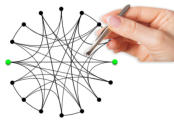
So single channel neurofeedback (NFB) may increase the Clustering
Coefficient “C” in the region below the electrode, say F3 in the illustration
below. Two channel neurofeedback, by introducing synchrony between
two sites, say F3 and P3 (the left FPN network), can add a long distance
shortcut to the connectome and reduce the average path length “L”. In
this way NFB acts as an adaptogen by increasing small world network
efficiency (increased “C” and decreased “L”), and by increasing
processing of complexity.
How does neurofeedback add random edges (connections)
to increase small world network efficiency?
“… simultaneous activation of two brain regions communicating through phase synchronization will probably also induce synaptic plasticity between these regions. This is particularly likely when phase synchronization-mediated communication occurs repeatedly or for an extended period…Moreover, if synaptic connections between two regions have been strengthened, phase synchronization may be more easily induced, and the two regions will be more likely to communicate with each other.” Fell et al 2011.
General references for this page
Borjigin J, et al (2013) - Surge of neurophysiological coherence and
connectivity in the dying brain. Proc Nat Acad Sci, Aug 14, 2013. [Free
Full Text]
Daniels JK, et al (2011) - Default mode alterations in posttraumatic
stress disorder related to early-life trauma - a developmental
perspective. J Psychiatry Neurosci 2011;36(1) p56. [Free Full Text]
Fair DA, et al (2008) - Fair DA, et al (2008) - The maturing architecture
of the brain's default network. Proc Nat Acad Sci. Vol 105, no. 10, Mar
11, 2008, 4028-4032. [Free Full Text]
Fell J, et al (2011) - The role of phase synchronization in memory
processes. Nature Reviews Neuroscience, Vol 12, Feb 2011, pp 105-118.
[Abstract]
Servaas MN, et al (2015) - Connectomics and Neuroticism - An
Altered Functional Network Organization. Neuropsychopharmacology
40, 296-304. [Abstract]

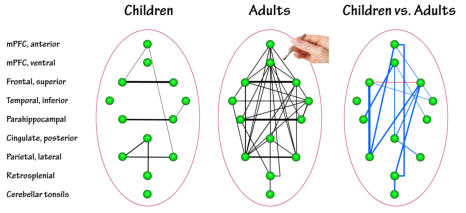
Craniopathy, Small World Networks and Neurofeedback.
“... the human skull is a small world network, with two well delimited connectivity modules: one facial organized around the ethmoid bone, and one cranial organized around the sphenoid bone.” [1] This is a wonderful example of the nested embedding of small world networks. The SWNs of the brain are embedded in the more rigid SWNs of the cranium, embedded in the SWNs of body, environmental, social, technological and informational SWNs. It is not surprising that disturbances in the small world networks of the brain’s cranial environment can lead to executive dysfunction [3]. Neurofeedback may be facilitated by recognizing the role of the craniosacral reciprocal tension network in executive dysfunction as well as susceptibility to chronic naso-sinus fungal biofilm [4] and direct brain reactivity [5]. Network support and neuroplasticity (needed for effective NFB) can be impaired due to common TMJ and bite problems - “occlusal disharmony” [6, 7]. It is interesting to reconsider Janet Travell who on page 112 of Volume 1 of “Myofasical Pain and Dysfunction” cites her experience with orthotics to correct postural instability due to Morton’s foot (a second metatarsal or toe longer than the first). Within moments of standing on corrective orthotics some clients could open their jaws 20-30% wider. It is also interesting to know that recently “Morton’s long second toe” has been found to be a genetic marker for pyridoxal 5’ phosphate single nucleotide polymorphisms which have a great effect of neuroprotection and neuroplasticity, glucose tolerance, metabolic syndrome, etc. [8] [1] Esteve-Altava B, et al (2013) - Grist for Riedl's mill: a network model perspective on the integration and modularity of the human skull. J Exp Zool B Mol Dev Evol. 2013 Dec; 320(8):489-500. [Abstract] [2] Brook AH, et al (2014) - General and craniofacial development are complex adaptive processes influenced by diversity. Aust Dent J. 2014 Jun; 59 Suppl 1:13-22. [Abstract] [3] Beckett JS, et al (2014) - Altered brain connectivity in sagittal craniosynostosis. J Neurosurg Pediatr. 2014 Jun; 13(6):690-8. [Abstract] [4] Brewer JH, et al (2014) - Chronic illness associated with mold and mycotoxins - is naso-sinus fungal biofilm the culprit. Toxins 6, 66-80. [Free Full Text] [5] Kare MR, et al (1969) - Direct Pathway to the Brain. Science, Vol. 163, No 3870 (Feb 28, 1969), pp. 952-953. [Abstract] [6] Mori D, et al (2013) - Occlusal disharmony leads to learning deficits associated with decreased cellular proliferation in the hippocampal dentate gyrus of SAMP8 mice. Neuroscience Letters 534 ( 2013) 228-232. [Abstract] [7] Kubo KY, et al (2007) - Occlusal disharmony induces spatial memory impairment and hippocampal neuron degeneration via stress in SAMP8 mice. Neuroscience Letters 414 (2007) 188-191. [Abstract] [8] Nichols TW, et al (2014) - Morton's foot and pyridoxal 5'- phosphate deficiency: genetically linked traits. Med Hypotheses. 2014 Dec; 83(6):644-8. [Abstract]























